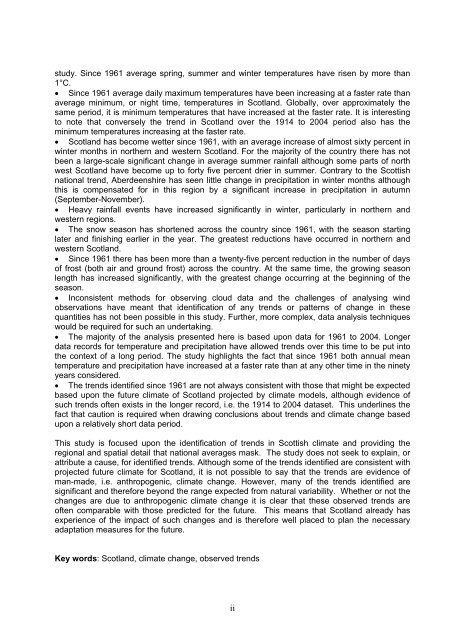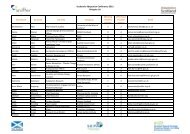Patterns of climate change across Scotland: technical report - Sniffer
Patterns of climate change across Scotland: technical report - Sniffer
Patterns of climate change across Scotland: technical report - Sniffer
You also want an ePaper? Increase the reach of your titles
YUMPU automatically turns print PDFs into web optimized ePapers that Google loves.
study. Since 1961 average spring, summer and winter temperatures have risen by more than<br />
1°C.<br />
• Since 1961 average daily maximum temperatures have been increasing at a faster rate than<br />
average minimum, or night time, temperatures in <strong>Scotland</strong>. Globally, over approximately the<br />
same period, it is minimum temperatures that have increased at the faster rate. It is interesting<br />
to note that conversely the trend in <strong>Scotland</strong> over the 1914 to 2004 period also has the<br />
minimum temperatures increasing at the faster rate.<br />
• <strong>Scotland</strong> has become wetter since 1961, with an average increase <strong>of</strong> almost sixty percent in<br />
winter months in northern and western <strong>Scotland</strong>. For the majority <strong>of</strong> the country there has not<br />
been a large-scale significant <strong>change</strong> in average summer rainfall although some parts <strong>of</strong> north<br />
west <strong>Scotland</strong> have become up to forty five percent drier in summer. Contrary to the Scottish<br />
national trend, Aberdeenshire has seen little <strong>change</strong> in precipitation in winter months although<br />
this is compensated for in this region by a significant increase in precipitation in autumn<br />
(September-November).<br />
• Heavy rainfall events have increased significantly in winter, particularly in northern and<br />
western regions.<br />
• The snow season has shortened <strong>across</strong> the country since 1961, with the season starting<br />
later and finishing earlier in the year. The greatest reductions have occurred in northern and<br />
western <strong>Scotland</strong>.<br />
• Since 1961 there has been more than a twenty-five percent reduction in the number <strong>of</strong> days<br />
<strong>of</strong> frost (both air and ground frost) <strong>across</strong> the country. At the same time, the growing season<br />
length has increased significantly, with the greatest <strong>change</strong> occurring at the beginning <strong>of</strong> the<br />
season.<br />
• Inconsistent methods for observing cloud data and the challenges <strong>of</strong> analysing wind<br />
observations have meant that identification <strong>of</strong> any trends or patterns <strong>of</strong> <strong>change</strong> in these<br />
quantities has not been possible in this study. Further, more complex, data analysis techniques<br />
would be required for such an undertaking.<br />
• The majority <strong>of</strong> the analysis presented here is based upon data for 1961 to 2004. Longer<br />
data records for temperature and precipitation have allowed trends over this time to be put into<br />
the context <strong>of</strong> a long period. The study highlights the fact that since 1961 both annual mean<br />
temperature and precipitation have increased at a faster rate than at any other time in the ninety<br />
years considered.<br />
• The trends identified since 1961 are not always consistent with those that might be expected<br />
based upon the future <strong>climate</strong> <strong>of</strong> <strong>Scotland</strong> projected by <strong>climate</strong> models, although evidence <strong>of</strong><br />
such trends <strong>of</strong>ten exists in the longer record, i.e. the 1914 to 2004 dataset. This underlines the<br />
fact that caution is required when drawing conclusions about trends and <strong>climate</strong> <strong>change</strong> based<br />
upon a relatively short data period.<br />
This study is focused upon the identification <strong>of</strong> trends in Scottish <strong>climate</strong> and providing the<br />
regional and spatial detail that national averages mask. The study does not seek to explain, or<br />
attribute a cause, for identified trends. Although some <strong>of</strong> the trends identified are consistent with<br />
projected future <strong>climate</strong> for <strong>Scotland</strong>, it is not possible to say that the trends are evidence <strong>of</strong><br />
man-made, i.e. anthropogenic, <strong>climate</strong> <strong>change</strong>. However, many <strong>of</strong> the trends identified are<br />
significant and therefore beyond the range expected from natural variability. Whether or not the<br />
<strong>change</strong>s are due to anthropogenic <strong>climate</strong> <strong>change</strong> it is clear that these observed trends are<br />
<strong>of</strong>ten comparable with those predicted for the future. This means that <strong>Scotland</strong> already has<br />
experience <strong>of</strong> the impact <strong>of</strong> such <strong>change</strong>s and is therefore well placed to plan the necessary<br />
adaptation measures for the future.<br />
Key words: <strong>Scotland</strong>, <strong>climate</strong> <strong>change</strong>, observed trends<br />
ii



